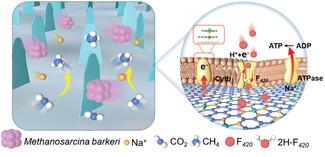当前位置:
X-MOL 学术
›
Adv. Mater.
›
论文详情
Our official English website, www.x-mol.net, welcomes your
feedback! (Note: you will need to create a separate account there.)
Revealing Co-N4@Co-NP Bridge-Enabled Fast Charge Transfer and Active Intracellular Methanogenesis in Bio-Electrochemical CO2-Conversion with Methanosarcina Barkeri
Advanced Materials ( IF 27.4 ) Pub Date : 2023-09-10 , DOI: 10.1002/adma.202304920 Rongxin Xia 1 , Jun Cheng 1, 2 , Zhuo Chen 1 , Ze Zhang 3, 4 , Xinyi Zhou 1 , Junhu Zhou 1 , Meng Zhang 5
Advanced Materials ( IF 27.4 ) Pub Date : 2023-09-10 , DOI: 10.1002/adma.202304920 Rongxin Xia 1 , Jun Cheng 1, 2 , Zhuo Chen 1 , Ze Zhang 3, 4 , Xinyi Zhou 1 , Junhu Zhou 1 , Meng Zhang 5
Affiliation

|
To significantly advance the bio-electrochemical CO2-conversion rate and unfold the correlation between the abiotic electrode and the attached microorganisms, an atomic-nanoparticle bridge of Co-N4@Co-NP crafted in metal–organic frameworks-derived nanosheets is integrated with a model methanogen of Methanosarcina barkeri (M. barkeri). The direct bonding of N in Co-N4 and Fe in member protein of Cytochrome b (Cytb) activates a fast direct electron transfer path while the Co nanoparticles further strengthen this bonding via decreasing the energy gap between the p-band center of N and the d-band center of Fe. This multiorbital tuning operation of Co nanoparticles also enhances the coenzyme F420-mediated electron transfer by enabling the electron flow direct to the hydrogenation sites. Particularly, the increased surface electric field of the Co-N4@Co-NP bridge-based nanosheet electrode facilitates the interfacial Na+ accumulation to expedite ATPase transport for powering intracellular CO2 conversion. Remarkably, the self-assembled M.barkeri-Co-N4@Co-NP biohybrid achieves a high methane production rate of 3860 mmol m−2 day−1, which greatly outperforms other reported biohybrid systems. This work demonstrates a comprehensive scrutinization of biotic–abiotic energy transfer, which may serve as a guiding principle for efficient bio-electrochemical system design.
中文翻译:

揭示甲烷八叠球菌生物电化学 CO2 转化中的 Co-N4@Co-NP 桥快速电荷转移和活跃的细胞内产甲烷作用
为了显着提高生物电化学CO 2转化率并揭示非生物电极与附着微生物之间的相关性,集成了由金属有机框架衍生的纳米片制成的Co-N 4 @Co-NP原子-纳米颗粒桥与巴克甲烷八叠球菌( M. barkeri )的模型产甲烷菌。 Co-N 4中的 N 和细胞色素 b (Cytb) 成员蛋白中的 Fe 的直接键合激活了快速直接电子转移路径,而 Co 纳米颗粒通过减小 N 和 Fe 的 p 带中心之间的能隙进一步增强了这种键合。 Fe的d带中心。 Co纳米颗粒的这种多轨道调谐操作还通过使电子流直接流向氢化位点来增强辅酶F420介导的电子转移。特别是,Co-N 4 @Co-NP桥式纳米片电极表面电场的增加促进了界面Na + 的积累,从而加速了ATP酶的运输,从而为细胞内CO 2转化提供动力。值得注意的是,自组装的M.barkeri -Co-N 4 @Co-NP生物杂交系统实现了3860 mmol m -2 day -1的高甲烷生产率,这大大优于其他报道的生物杂交系统。这项工作展示了对生物-非生物能量转移的全面审查,这可以作为高效生物电化学系统设计的指导原则。
更新日期:2023-09-10
中文翻译:

揭示甲烷八叠球菌生物电化学 CO2 转化中的 Co-N4@Co-NP 桥快速电荷转移和活跃的细胞内产甲烷作用
为了显着提高生物电化学CO 2转化率并揭示非生物电极与附着微生物之间的相关性,集成了由金属有机框架衍生的纳米片制成的Co-N 4 @Co-NP原子-纳米颗粒桥与巴克甲烷八叠球菌( M. barkeri )的模型产甲烷菌。 Co-N 4中的 N 和细胞色素 b (Cytb) 成员蛋白中的 Fe 的直接键合激活了快速直接电子转移路径,而 Co 纳米颗粒通过减小 N 和 Fe 的 p 带中心之间的能隙进一步增强了这种键合。 Fe的d带中心。 Co纳米颗粒的这种多轨道调谐操作还通过使电子流直接流向氢化位点来增强辅酶F420介导的电子转移。特别是,Co-N 4 @Co-NP桥式纳米片电极表面电场的增加促进了界面Na + 的积累,从而加速了ATP酶的运输,从而为细胞内CO 2转化提供动力。值得注意的是,自组装的M.barkeri -Co-N 4 @Co-NP生物杂交系统实现了3860 mmol m -2 day -1的高甲烷生产率,这大大优于其他报道的生物杂交系统。这项工作展示了对生物-非生物能量转移的全面审查,这可以作为高效生物电化学系统设计的指导原则。































 京公网安备 11010802027423号
京公网安备 11010802027423号